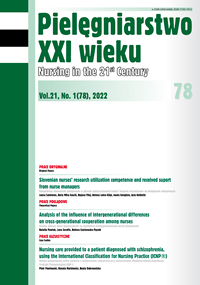Mobbing and its eff ects on the health of a selected sample of nurses in the Czech Republic
DOI:
https://doi.org/10.2478/pielxxiw-2022-0008Keywords:
mobbing, health of nurses, NAQ-R, GHQ-28Abstract
MOBBING AND ITS EFFECTS ON THE HEALTH OF A SELECTED SAMPLE OF NURSES IN THE CZECH REPUBLIC
Introduction. Mobbing is a systemic problem that aff ects all work sectors, including the healthcare sector. Healthcare professionals are a group that is exposed to a high level of stress and thus, to the risk of negative situations in the workplace. The prevalence of mobbing in nurses is high. Mobbed nurses more often suff er from stressful headaches, insomnia, anxiety and describe depressive symptoms.
Aim. The aim of this study is to determine the rate of mobbing in a selected sample of nurses and to describe how nurses perceive their state of health. To determine whether there is a statistically signifi cant connection among the incidence of mobbing, perceived state of health, age of nurses and the length of their practice.
Material and methods. A descriptive, cross-sectional study was performed. The standardized tools Negative Acts Questionnaire-
Revised and General Health Questionnaire-28 were used. The research group consisted of nurses working in the acute care departments of selected medical facilities.
Results. A total number of 715 nurses from all the regions of the Czech Republic participated in the study. The rate of nurses’
experience with negative acts in the workplace is 79.3%. Mobbed nurses report health disorders more often, especially in the area of somatic symptoms, anxiety, and insomnia. A higher number of negative acts are reported by younger nurses with a shorter period of overall nursing practice.
Conclusions. The occurrence of mobbing in the selected sample of nurses in the Czech Republic was confi rmed. Mobbed nurses
perceive and report deteriorating of their health condition.
References
1.Topa G, Moriano JA. Stress and nurses’ horizontal mobbing: Moderating eff ects of group identity and group support. Nursing outlook. 2013; 61(3): 25-31. https://doi.org/10.1016/j.outlook.2013.03.002.
2. Bowling NA, Beehr TA. Workplace harassment from the victim’s perspective:
A theoretical model and meta-analysis. Journal of Applied Psychology. 2006; 91(5):998-1012. https://doi.org/10.1037/0021-9010.91.5.998
3. Durmus SC, Topcu I, Yildirim A. Mobbing Behaviors Encountered by Nurses and their Eff ects on Nurses. International Journal of Caring Sciences. 2018; 11(2): 905-915. http://internationaljournalofcaringsciences.org/docs/32_durmus_original_10_2.pdf.
4. Zachariadou T, Zannetos S, Chira SE, et al. Prevalence and Forms of Workplace Bullying Among Health-care Professionals in Cyprus: Greek Version of “Leymann Inventory of Psychological Terror” Instrument. Safety and Health at Work. 2018; 9(3): 339-346. https://doi.org/10.1016/j.shaw.2017.11.003.
5. Myers G, Cote-Arsenault D, Worral P, et al. A cross-hospital exploration of nurses’´ experiences with horizontal violence. Journal of Nursing Management. 2016; 24: 624-633. https://doi.org/10.1111/jonm.12365.
6. Difazio RL, Vessey, JA, Buchko OA, et al. The incidence and outcomes of nurse bullying in the Russian Federation. International Nursing Review. 2019; 66: 94-103. https://doi.org/10.1111/inr.12479.
7. Einarsen S, Hoel H, Notelaers G. Measuring exposure to bullying and harassment at work: Validity, factor structure and psychometric properties of the Negative Acts Questionnaire-Revised, Work & Stress. 2009; 23(1): 24-44. https://doi. org/10.1080/02678370902815673
8. Olweus D. Bully/victim problems in school. Basic facts and an eff ective intervention programme. [In:] Einarsen S, Hoel H, Zapf D, Cooper CL (Eds.). Bullying and emotional abuse in the workplace. London: Taylor & Francis. 2009; 62-78. ISBN 0-415-25359-4.
9. Aksakal FN, Karaşahin EF, Dikmen AU, et al. Workplace physical violence, verbal violence, and mobbing experiencedby nurses at a university hospital. Turkish journal of medical sciences, 2015; 45(6): 1360-1368. https://journals.tubitak.gov.tr/ medical/abstract.htm?id=17627
10. Ekici D, Beder A.The eff ects of workplace bullying on physicians and nurses.
Australian Journal of Advanced Nursing, 2014; 31(4), 24-33. https://www.ajan.com. au/archive/Vol31/Issue4/3Ekici.pdf
11. Chatziioannidis I, Bascilla FG, Chatzivalsama P, et al. Prevalence, causes and mental health impact of workplace bullying in the Neonatal Intensive Unit Care environment. BMJ Open. 2018; 8: e018766. http://dx.doi.org/10.1136/bmjopen-2017-018766.
12. Figueiredo-Ferraz H, Gil-Monte PR, Olivares-Faúndez VE. Influence of mobbing (workplace bullying) on depressivesymptoms: a longitudinal study among employees working with people with intellectual disabilities. Journal of Intellectual Disability Research. 2015; 59(1): 39-47. https://onlinelibrary.wiley.com/doi/ epdf/10.1111/jir.12084
13. Tatar ZB, Yüksel Ş. Mobbing at workplace–psychological trauma and documentation of psychiatric symptoms. Archives of Neuropsychiatry. 2019; 56(1): 57-62 doi: 10.29399/npa.22924.
14. Beňo P. Můj šéf, můj nepřítel?. Šlapanice: Era; 2003: 181 s. Kariéra. ISBN 80-86517-34-9.
15. Goris S, Ceyha, O, Tasci S, et al. Mobbing against Nurses in Turkey: How Does it Aff ect Job Satisfaction. International Journal of Caring Sciences. 2016; 9(3): 810-818. http://internationaljournalofcaringsciences.org/docs/9_goris_ABSTRACT_9_3.pdf.
16. Haddad LM, Annamaraju P, Toney-Butler TJ. Nursing shortage. StatPearls; 2020. [Internet]. https://www.ncbi.nlm.nih.gov/books/NBK493175/
17. Johnson AH, Benham‐Hutchins M. The infl uence of bullying on nursing practice errors: a systematic review. AORN journal. 2020; 111(2): 199-210. https://doi. org/10.1002/aorn.12923
18. Özkan Şat S, Akbaş P, Yaman Sözbir Ş. Nurses’ exposure to violence and their professional commitment during the COVID‐19 pandemic. Journal of clinical nursing. 2021; 30(13-14): 2036-2047. https://doi.org/10.1111/jocn.15760.
19. Al-Ghabeesh H, Qattom H. Workplace bullying and its preventive measures and productivity among emergency department nurses. Israel Journal Health Policy Research. 2019; 8(44): 1-7. https://doi.org/10.1186/s13584-019-0314-8.
20. Kozáková R, Bužgová R, Zeleníková R. Mobbing of nurses: prevalence, forms
and psychological consequences in the Moravian Silesian region. Czechoslovak
Psychology. 2018; 62(4): 316-329. http://cspsych.psu.cas.cz/result.php?id=1022
21. Al-Sagarat A, Qan´ir Y, Al-Azzam M, et al. Assessing the impact of workplace bullying on nursing competences among registered nurses. Jordanian Nursing and Health Sciences. 2016; 18(2): 172-179. https://doi.org/10.1111/nuf.12253.
22. Carter M, Thompson M, Crampton P, et al. Workplace bullying in the UK NHS: a questionnaire and interview study on prevalence, impact and barriers to reporting.
BMJ Open. 2013. 3:e002628. http://dx.doi.org./10.1136/bmjopen-2013-002628.
Downloads
Published
Issue
Section
License
Copyright (c) 2022 Authors

This work is licensed under a Creative Commons Attribution 4.0 International License.




